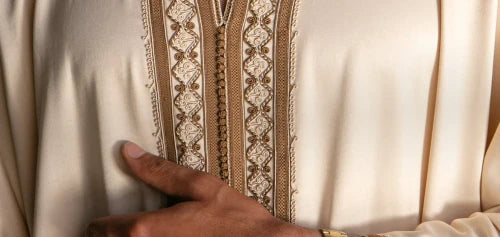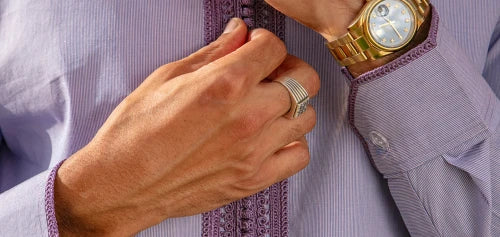What is a Haik?
The haik, pronounced ha-yek, and also spelt ha'ik, is a long-standing symbol of Moroccan identity. It has deep roots in North African cultural and religious traditions. Historically worn by Moroccan city women, the haik is a large piece of fabric, often made from white or cream coloured wool or cotton. It drapes over the body, concealing the body shape and veiling the facial features. This garment was essential for modesty, particularly in urban areas, and was a common sight on the streets until the mid-20th century. It was more popular to wear in the cities because there were more people in the cities. The city streets were busier than those in more rural areas of Morocco where women rarely went out, and if they did, they would not expect to see anyone.

Featured image and above image source: picryl.com
The Haik Origins
The origins of the haik date back centuries, serving as both a practical and symbolic one or sometimes two piece garment. It was traditionally worn for religious reasons, as it adhered to Islamic principles of modesty, while also acting as a marker of cultural identity. The haik was particularly prevalent among urban women who were more likely to go out to work, or seek education etc. Contrasting with rural Berber women, who often stayed or worked from home and did not feel the need to veil their faces.
As Morocco began to open up to international trade in the 19th century, the country experienced an influx of foreign influences that began to shape its fashion landscape. The haik, once a staple of Moroccan city life, started to evolve as new materials and styles were introduced. Despite these changes, the haik never lost its core purpose—maintaining modesty and preserving cultural heritage.

Image source: picryl.com
The Haik Today
Today, while fewer women wear the haik as daily attire, it remains an important symbol, especially during cultural and religious events. Some women continue to wear it to express their religious devotion, while others don it to honor traditional values. The haik’s evolution reflects the broader changes in Moroccan society, where tradition and modernity coexist.
Morocco’s clothing culture is as diverse as its landscapes, with each region showcasing unique garments that tell the story of its people. From the vibrant colors of Berber clothing to the elegant drapes of the caftan, Moroccan attire is a celebration of the country’s rich history and cultural diversity. The haik, with its enduring legacy, remains a powerful emblem of Moroccan identity, bridging the past and the present.

Image source: picryl.com
The Haik vs Modern Islamic Garments
The traditional Moroccan Haik shares similarities with modern Islamic garments like the Hijab, Abaya, and Khimaar, all of which emphasize modesty and provide the required coverage. The Haik is known to be white or very light in colour, often an all-in-one or 2 piece garment. Where as the Abaya, khimaar and Niqab are known to be primarily black or of dark colours.
The Haik was designed for simplicity and quick use, particularly for women who needed to just run some quick and essential errands. Women back then didn't go out much, they didn't travel often, eat out in public or go on day-long shopping sprees. It was practical for its time, but as lifestyles evolved, so did the need for more versatile options.
Modern garments, such as the Abaya, Khimaar, and Niqaab, offer the same level of modesty as the Haik but with added convenience for contemporary life. The Abaya is a long, flowing cloak or dress; the Khimaar is a headscarf that covers the hair, neck, shoulders and upper half of the womens body; and the Niqaab is a seperate face veil. Together, these three pieces provide full coverage similar to the Haik, but they can be worn and adjusted separately. This separation allows for greater practicality, especially in scenarios where one piece might need to be cleaned or adjusted without disturbing the entire outfit.

For example, if the Niqaab becomes dirty while eating out, it can be easily removed and washed without the need to clean the entire garment, as would be required with the Haik. Additionally, in windy conditions, the three-piece ensemble offers extra protection, ensuring that coverage is maintained without the risk of the entire garment being displaced.
The transition from the Haik to these modern garments reflects the changing needs of women over time. While the Haik served its purpose well in a time when women primarily stayed close to home, modern Islamic attire provides the flexibility and practicality needed in today’s more dynamic lifestyle, allowing women to maintain modesty while navigating various activities throughout the day.
Conclusion
In the bustling markets of cities like Fez and Marrakech, where old and new blend seamlessly, the haik stands as a reminder of Morocco’s deep-rooted traditions. It is not just a piece of fabric; it is a piece of history, woven with the threads of faith, culture, and resilience. Whether worn for religious reasons or as a tribute to ancestral customs, the haik continues to hold a special place in the hearts of Moroccan women.









